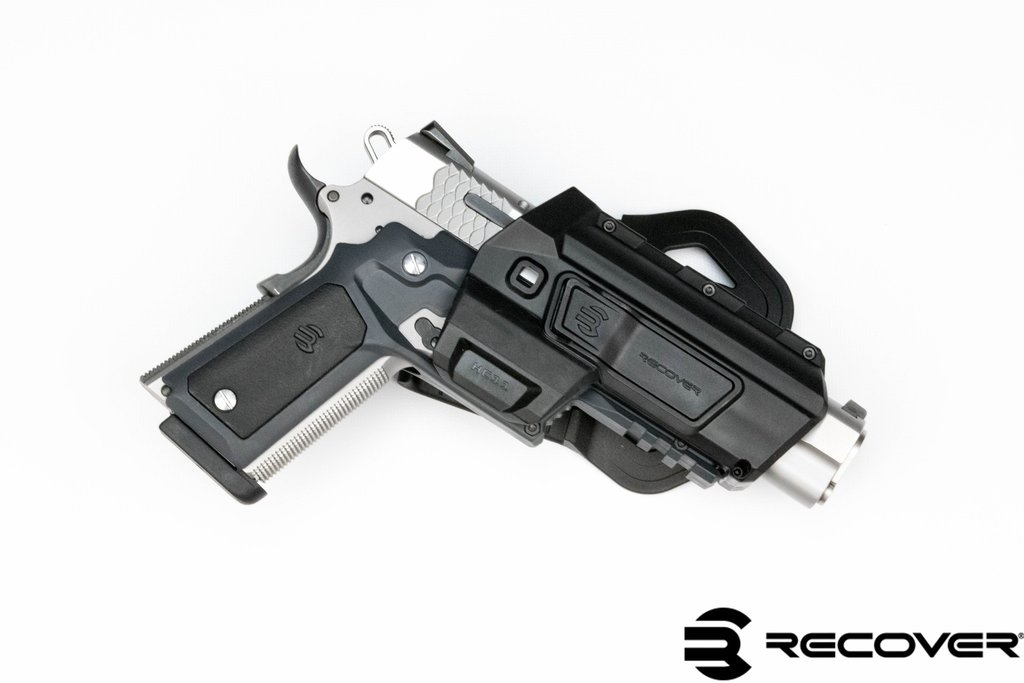The Recover Tactical CC3 takes your non-rail 1911 and gives it a solid integral rail 1.8 inches long. The size and feel are indistinguishable by the shooter from a high-dollar integral rail gun.
There are few really new ideas in the gun world. In an upgrade from flaming arrow technology, lights and guns have been paired for 100 years or so. Tamir Porat (designer of the Tavor rifle used by the Israeli Defense Forces) has come up with a clever way to put a rail on your vanilla 1911 for less than $50. This got my attention, and I pulled out all the stops to get one.
The first hand-held flashlight was patented in 1903 by a Russian immigrant named Conrad Hubert. Because it was invented in America, people immediately attached them to guns. This worked great unless you shot the gun, in which case the fragile filament inside the bulb broke.
My faith tradition tells me that at the beginning of the twentieth century, God revealed the short recoil principle of operation to his servant, John Moses Browning, in a vision. During a legendary 6,000 round test, fired over two days in 1910, the U.S. Army recognized the divinely simple and rugged single action semi-automatic perfection and adopted it as the as the Model 1911 on March 29, 1911.
Meanwhile, George Seely was in San Francisco perfecting a firearm-mounted light with a spring and rubber cushion so you could fire your gun more than once before the light broke. Patent Number 1,029,951 for the “Night Sight For Firearms” was granted on June 18, 1912.
Since 1912, there have been hundreds of ideas on how to mount lights to 1911s. Most of them involved a grip with a rail on it, or some kind of screw attachment to the dust cover. I never had any luck with these attachments, they always seemed to shoot loose with the .45 caliber recoil.
About 15 years ago, manufacturers started producing 1911s with integral rails. I am a big fan of gun-mounted lights, and integrated light rails are the gold standard. With no light, how are you going to see the looks on their faces? The Marines understand this – the Picatinny-railed Colt M45A1 CQBP has now been adopted by Marine Corps, making the railed 1911 official U.S. military gear.

1911 pistols have had grips made from every imaginable material, from exotic tropical hard woods to cheap plastic. Recover Tactical’s CC3 1911 Grip is made of polymer composite, which has a feel much like polymer frame guns. It is about the same thickness as regular grips and weighting in at only 2.8 ounces.

Photo credit Dexter9091911 www.calguns.net
The CC3 takes your non-rail 1911 and gives it a solid integral rail 1.8 inches long. The size and feel are indistinguishable by the shooter from a high-dollar integral rail gun. The CC3 grips install in minutes. The universal fit comes from two pieces that screw together over your 1911 and replace your grips. They come in olive drab, desert tan, and classic black. MSRP is $49.99

Photo Credit Skyhunter357 www.calguns.net
Recover says the CC3 was designed to fit on any standard model 1911 pistol and most 1911 standard frame replica airsoft guns. The CC3 will fit on all barrel sizes down to the 4.25″ Colt Commander. It will not fit on anything besides full-sized frames or a full-sized frame with a shorter barrel, like the Commander.
I took the CC3 to the range with high hopes and a bag of borrowed Tripp Research magazines. I tried them on three different standard size 1911s: A Remington 1911A1, a Springfield 1911 and a Charles Daly 1911 with ambidextrous safeties and an extended magazine catch. I had no major issues; the grips attach easily with your grip screws and two additional screws holding the rail halves together.
The CC3 is about the same thickness (1.25 inches) as a 1911 with regular original grips. The Recover CC3 adds the same amount of thickness to the front strap as standard wrap around style grip.
After 300 rounds of Federal Classic 230 grain jacketed hollow points, I found no flaws with the CC3. The feel was similar to regular grips with modestly aggressive ridges like a stippled polymer gun. Once mounted, the lights were stable and there were no issues with the controls on guns or lights. With a light mounted, there is a slight, but comfortable, front heavy feel which reduces muzzle flip and helps rapid follow up shots.
The CC3 fit all my 1911s, but the Charles Daly took a little fitting with a Dremil around the trigger guard. The polymer is much like the material in polymer firearms and easy to work with. There were small gaps between the halves on the underside of the gun but I couldn’t feel them, and a light covers the gaps on the rail. Additional fitting could have easily fixed it, but it worked so I left well enough alone.
Proper installation and use of the Recover grip and rail will not damage your gun. There are no modifications required to install the Recover, and the polymer composite will not scratch metal.
I used three different lights: the Streamlight TLR-1, Safariland Rapid Light System (RLS), and the Insight M3. All mounted and dismounted easily and functioned as designed. The controls were easily reached and manipulated. They were stable during live fire.
Videos
CC3 Installation Video
Recover also makes holsters for guns with their grips.

Ready to order? Visit the Recover Tactical Website.
Recover Tactical Facebook Page
























COMMENTS
There are on this article.
You must become a subscriber or login to view or post comments on this article.